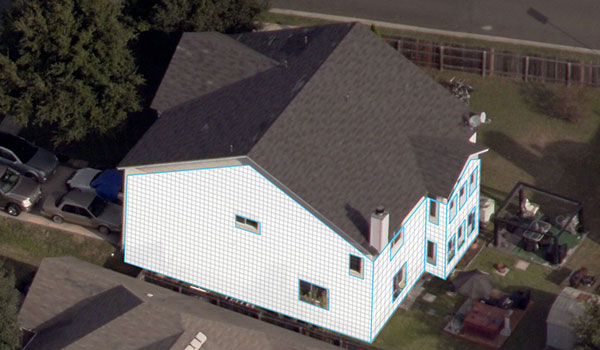
Already familiar with EagleView Technologies’
aerial roof measurement reports, a large, national insurance carrier learned about the company’s
Wall Report and was eager to try it out for
claims that involve damage to siding or windows.
The carrier’s field claims manager explained that often they would receive claims that not only were for roof damage but also included damage to the siding or windows. “We were using the EagleView roof reports for the roof measurement, but the claim would be slowed down by having to send a person out to the house to manually measure the siding or windows,” he explained. When he learned about the
ClaimsReady™ wall measurement report that is produced using EagleView’s patented 3D technologies, he wanted to learn more and determine how implementing this technology would impact his company in terms of time, efficiency and from a financial perspective.
EagleView agreed to work closely with the carrier to study a sample of 1,200 closed claims and evaluate the results. EagleView wall measurement reports were generated for each of the properties. The carrier also decided to re-measure the properties by hand to double check the original accuracy. To accomplish this, they engaged their own national CAT and re-inspection teams.
Accuracy and Time
In evaluating the results of the original adjusters’ hand measurements, the EagleView measurements, and the new, double-checked hand measurements performed by the CAT and re-inspection teams, the carrier was able to determine that the adjusters were more likely to over measure 79% of the time with an average overage of 10.87% or 239 square feet per claim.
For a typical claim, it can take a few days for an adjuster to visit the property to collect measurements, meet with the owner and begin the estimating process. The use of EagleView wall reports, when ordered at first notice of loss, produced process improvements that resulted in a shortened claims cycle and better experience for the property owner. The reports were typically delivered the same day they were ordered which allowed the adjuster to have the report in hand when they met with the owner.
Another benefit was that time previously spent measuring is now time spent with the property owner. There was also an impact on safety as adjusters no longer have to climb potentially unsafe structures to gather measurements. According to the field claims manager, the adjusters love using the reports. “The EagleView report saves them time and allows them to focus on what they do best – writing an estimate and servicing the policyholder versus measuring everything,” he said.
ROI Analysis
The numbers from the study show a definite positive financial impact for the carrier. With an average over measurement of 239 square feet, 79 percent of the time, 948 of the 1,200 properties in the study were measured inaccurately. For purposes of this study, the cost of two dollars per square foot will be used to calculate costs. If 948 properties were over by 239 square feet each, this represents 226,572 square feet over. Multiply that by the estimated cost of two dollars per square and the overpayment equals $453,144, or $377 per claim.
There is some cost savings associated with not having to pay the adjusters for time spent measuring but that is going to be transferred into the cost of purchasing the EagleView report. For this study the average time spent measuring was 37 minutes per structure with a cost of $15.54 for time, based on a $25 per hour rate. Using these numbers, the total cost for adjusters to hand measure the 1,200 properties in the study was $18,648.
Let’s factor in the cost of the EagleView reports. With the carrier paying an average of $55 per report, the initial cost to order an EagleView report for every house in the study would have been $66,000. While that is three times the cost to pay adjusters to measure the house, the true ROI comes from the savings realized by paying claims based on accurate measurements. By subtracting the $18,648 adjuster payment cost from the $66,000 report cost, the carrier had a net increase of $47,352.
For this study, had the carrier made the additional $47,352 investment to purchase EagleView reports on every property, they would have saved $405,792 that was overpaid on these claims. This equates to $338 saved on each claim - a significant return on investment that convinced the carrier of the value of using EagleView wall reports for every exterior damage claim.
CSAT and Process Improvements
Needless to say, the carrier is now using EagleView reports on every claim. According to the field claims manager the company is able to complete a few more claims per day but for them it’s more about the safety, customer satisfaction, reduced inspection time, quality of the measurements and the accuracy.
He reports that, just as they have experienced with using EagleView roof reports, the accuracy of the wall reports takes measurement issues out of the equation, virtually eliminating disputes or the need to be called back for a re-measure. This allows the claim to be closed faster resulting in happier policyholders.
“We are a service industry. When you get it right the first time, it carries over into everything else,” explained the manager. “If you are off on your measurements, it can cause a conflict and starts eroding trust. When we are up front with customers and the contractor it removes the ambiguity and allows us to focus on the customer and the claims and not the measurements.“